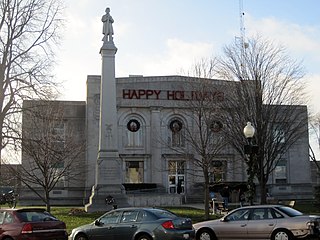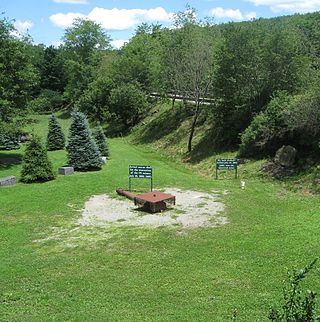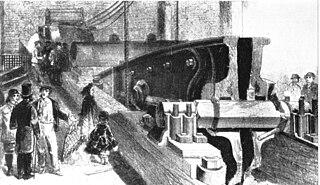
Grundy County is a county in the U.S. state of Illinois. According to the 2020 census, it has a population of 52,533. Its county seat is Morris.

Braidwood is a city in Will County, Illinois, United States, approximately 53 miles (85 km) southwest of Chicago and 18 miles (29 km) south of Joliet. The population was 6,191 at the 2010 census.
A mining accident is an accident that occurs during the process of mining minerals or metals. Thousands of miners die from mining accidents each year, especially from underground coal mining, although accidents also occur in hard rock mining. Coal mining is considered much more hazardous than hard rock mining due to flat-lying rock strata, generally incompetent rock, the presence of methane gas, and coal dust. Most of the deaths these days occur in developing countries, and rural parts of developed countries where safety measures are not practiced as fully. A mining disaster is an incident where there are five or more fatalities.

The Knox Mine disaster was a mining accident on January 22, 1959, at the River Slope Mine in Jenkins Township, Pennsylvania.

The Quecreek Mine rescue took place in Somerset County, Pennsylvania, when nine miners were trapped underground for over 77 hours, from July 24 to 28, 2002. All nine miners were rescued.

The Hartley Colliery disaster was a coal mining accident in Northumberland, England, that occurred on 16 January 1862 and resulted in the deaths of 204 men and children. The beam of the pit's pumping engine broke and fell down the shaft, trapping the men below. The disaster prompted a change in British law that required all collieries to have at least two independent means of escape.

The Cherry Mine disaster was a fire which occurred at the Cherry Mine, a coal mine outside Cherry, Illinois, on November 13, 1909. The fire, which killed 259 men and boys, is the third most deadly mine disaster in American coal mining history.

The Gresford disaster occurred on 22 September 1934 at Gresford Colliery, near Wrexham, when an explosion and underground fire killed 266 men. Gresford is one of Britain's worst coal mining disasters: a controversial inquiry into the disaster did not conclusively identify a cause, though evidence suggested that failures in safety procedures and poor mine management were contributory factors. Further public controversy was caused by the decision to seal the colliery's damaged sections permanently, meaning that only eleven of those who died were recovered.

The Coal Glen mine disaster was a series of explosions that occurred on May 27, 1925, at a coal mine in Coal Glen, Chatham County, North Carolina, United States. At least 53 miners died in the explosions, making it the deadliest industrial disaster in North Carolina's history. The incident also partly contributed to North Carolina's adoption of a workers' compensation law several years later.

Cardiff is a ghost town in Livingston County, Illinois, United States. Founded as a coal mining town in 1899, it boomed in its first few years. The closure of the mine in 1912 soon led to the community's demise. It is located in Round Grove Township, between the villages of Campus and Reddick.

Chatterley Whitfield Colliery is a disused coal mine on the outskirts of Chell, Staffordshire in Stoke on Trent, England. It was the largest mine working the North Staffordshire Coalfield and was the first colliery in the UK to produce one million tons of saleable coal in a year.

The Twin Shaft disaster occurred in the Newton Coal Company's Twin Shaft Colliery in Pittston, Pennsylvania, United States, on June 28, 1896, when a massive cave-in killed fifty-eight miners.
The Avondale Colliery was a coal mine in Plymouth Township, Luzerne County, near Plymouth, Pennsylvania in the small town of Avondale. The mine was considered to be "one of the best and worst" operating in Pennsylvania's Wyoming Valley.

The Avondale Mine disaster was a massive fire at the Avondale Colliery near Plymouth Township, Pennsylvania, on September 6, 1869. It caused the death of 110 workers. It started when the wooden lining of the mine shaft caught fire and ignited the coal breaker built directly overhead. The shaft was the only entrance and exit to the mine, and the fire trapped and suffocated 108 of the workers. It was the greatest mine disaster to that point in American history.

The White Ash Mine disaster occurred on 9 September 1889 at the White Ash Mine, an underground coal mine in Golden, Colorado. Ten men who had been working at the end of the lowest level were killed when the mine was accidentally flooded. Their bodies were never recovered and the mine was abandoned. It is likely that the flood was caused by a fire that weakened a barrier between the White Ash Mine and a nearby abandoned mine that was known to be flooded.
The Peckfield pit disaster was a mining accident at the Peckfield Colliery in Micklefield, West Yorkshire, England, which occurred on Thursday 30 April 1896, killing 63 men and boys out of 105 who were in the pit, plus 19 out of 23 pit ponies.

The Lundhill Colliery explosion was a coal mining accident which took place on 19 February 1857 in Wombwell, Yorkshire, UK in which 189 men and boys aged between 10 and 59 died. It is one of the biggest industrial disasters in the country's history and it was caused by a firedamp explosion. It was the first disaster to appear on the front page of the Illustrated London News.
Hapton Valley Colliery was a coal mine on the edge of Hapton near Burnley in Lancashire, England. Its first shafts were sunk in the early 1850s and it had a life of almost 130 years, surviving to be the last deep mine operating on the Burnley Coalfield.

Bentley Colliery was a coal mine in Bentley, near Doncaster in South Yorkshire, England, that operated between 1906 and 1993. In common with many other mines, it suffered disasters and accidents. The worst Bentley disaster was in 1931 when 45 miners were killed after a gas explosion. The site of the mine has been converted into a woodland.
The Diglake Colliery Disaster, was a coal-mining disaster at what was Audley Colliery in Bignall End, North Staffordshire, on 14 January 1895. A flood of water rushed into the mine and caused the deaths of 77 miners. Only three bodies were recovered, with efforts to retrieve the dead hampered by floodwater. 73 bodies are still entombed underground.
















